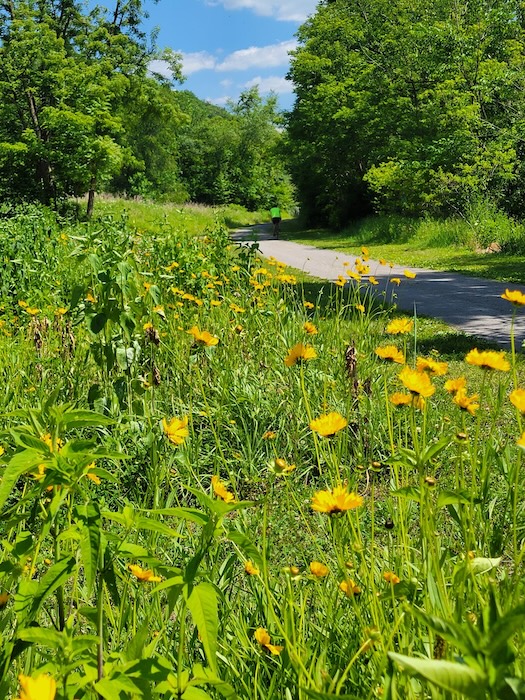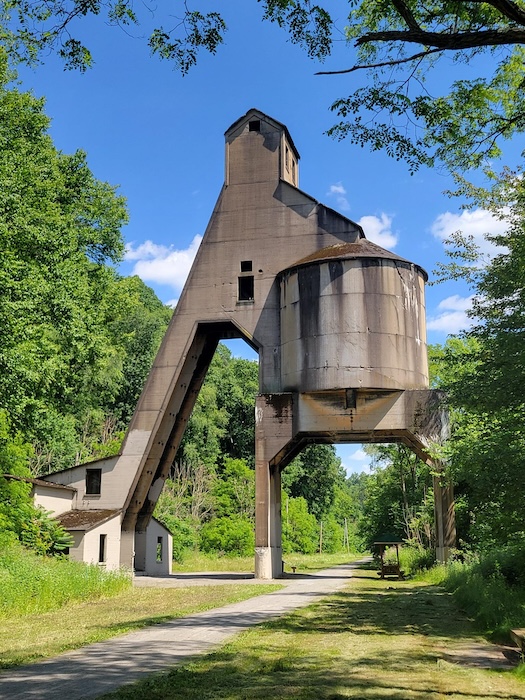Pennsylvania’s Armstrong Trails

Trail of the Month: July 2024
Western Pennsylvania’s industrial heyday may be behind it, but the towns surrounding the Armstrong Trails are embracing a newer economic strength in the region: outdoor recreation. This year, the 52.5-mile route—connecting more than a dozen communities in Armstrong, Clarion and Westmoreland counties—will be fully realized after more than three decades of effort made in large part by a strong network of community volunteers.
“The economic impact those trails have to little communities is overwhelming,” said avid cyclist and lifetime local resident J.R. Zrebny. “They bring a lot of people that would never come to that town for any other reason other than to ride bikes, to hike, or to walk on the trail.”
“When Virginia and I opened our shop, our goal was to try and do what is best for the community by promoting Freeport, honoring the past, recognizing the present and looking ahead to the future at the same time. I feel that the future is the trail.”
—Karen Heilman, owner of 1833 Coffee & Tea Co.
Northeast of Pittsburgh, the primarily crushed-stone trail takes a winding route along the east bank of the Allegheny River through the forested terrain of the Allegheny Plateau from Schenley to East Brady.
“I just like being along the river,” said Zrebny, who has ridden trails all over the country. “I like going through the little towns. It’s very scenic.”


Nearly complete, the current 48-mile trail system is expected to open a new 4-mile extension this summer, which will continue the route from Schenley to Leechburg along the north bank of the Kiskiminetas River (known as the Kiski River by locals). The final 0.5-mile piece, anticipated for this fall, will fill in a small gap on the north end of the trail where the Armstrong Trails meet up with the 50-mile Red Bank Valley Trail.
“By the end of October, our entire 52 and a half miles will be completed,” said Chris Ziegler, the executive director of Armstrong Trails. “You will be able to ride your bike from Brookville on the Red Bank Valley Trail the whole way to the Allegheny River, and then hop on the Armstrong Trails and go into Leechburg, and that’s over 100 miles. That’s when I think the full economic impact will really happen.”
Making Connections

Just this past April, a 10-mile stretch of the trail system opened from Manor Township, near the confluence of Crooked Creek and the Allegheny River, to the Kiski River in Gilpin Township. The project included revamping a showstopping bridge: the 726-foot Kiski Junction Railroad Bridge that dates back to 1899.
With these key pieces falling into place, trail advocates have made hopeful comparisons to the nearby Great Allegheny Passage (GAP, gaptrail.org), a popular 150-mile route stretching from Pittsburgh to Cumberland, Maryland, that connects several small, formerly industrial towns, similar to those along the Armstrong Trails. According to a recent analysis, the GAP generates an estimated $121 million in economic impact annually.
Increasing its reach and strengthening its potential impact, the Armstrong Trails are also critical to the Erie to Pittsburgh Trail, a regional effort to create a 270-mile north–south route through western Pennsylvania and into New York. Additionally, the Armstrong Trails have an important place in the Industrial Heartland Trails Coalition (IHTC) network, a Rails to Trails Conservancy TrailNation™ project that will establish over 1,500 miles of multiuse trails through Pennsylvania, New York, Ohio and West Virginia.
“The IHTC network vision doesn’t exist without the Armstrong Trails,” said Eric Oberg, Rails to Trails Conservancy’s Midwest regional director. “The fact that this region can envision such an audacious trail network is a testament to the legacy of the people that created the Armstrong Trails.”
Related: How the Great Allegheny Passage Transformed a Region
Trail History


Western Pennsylvania was once a hub for industry, including coal, steel, iron, petroleum, timber and railroads. Company towns popped up all over the area as the lifeblood that powered business and industry. The Armstrong Trails follow the former Allegheny Valley Railroad, and historical elements along the way honor this past, including a coaling tower, where trains would refuel with coal to power their steam engines, and a turntable that trains would use to reverse their travel direction. But as industry began to leave, many communities fell on tough times. By the 1970s, trains on the line stopped running.
“My grandfather was a foreman at the Schenley Distillery,” said Danny Mills, who returned to the area in 2016 to take care of his ailing mother. “There was a company town there. It’s all gone now.”
Today, Mills enjoys sharing the trail with his young son and is hopeful the trail’s revitalization of the area will bring more new people to the community. “I see people in the city that want to get out of overpriced properties, and maybe stretch their legs and live out here in the country.”
Back in 1983, Congress amended the National Trail Systems Act to create a process called railbanking, which allows rail corridors to be transformed into trails for interim use. This historic legislation has helped create of thousands of miles of rail-trails to date.
In 1992, the Allegheny Valley Land Trust (AVLT) purchased the rail corridor from Conrail for the development of a trail, and the following year, the Armstrong Rails to Trails Association (ARTA) was established as a nonprofit to pursue that goal. But while Conrail was willing to sell the corridor, they refused to railbank it with the Surface Transportation Board (STB, the governing body for railbanking). Instead, language was placed in the deed stating that the corridor was available for future rail service, which essentially railbanked the corridor directly with AVLT, according to Andrea Ferster, general counsel for RTC.
However, some residents along the corridor believed that once Conrail abandoned the line, any property easements reverted back to the landowners. As planners began laying the groundwork for the trail, landowners were getting lawyers.
The resulting lawsuit, Moody v. Allegheny Valley Land Trust, was filed in 1995 and made it all the way to the Pennsylvania Supreme Court, where RTC filed an amicus brief in support of the trail project. Ultimately, the court disagreed with the landowners, asserting in 1999 that “private railbanking” was allowed—the first state court to establish such a principle, said Ferster. The case set an important precedent validating the use of railbanking as a tool, even where the STB has no jurisdiction.
During the lawsuit, only a few miles of the trail were built. Once the legal battle was over, it was time to get to work to build more.
Related: Rail-Trail Cases That Have Shaped the Movement
It Takes a (Volunteer) Village

Ron Steffey was once a coal miner who suffered a devastating work injury that crushed his right foot. Unable to walk, Steffey discovered he could ride his bike in low gears and hoped it would aid in circulation to his foot. Knowing he couldn’t return to the mine, he began working for AVLT to develop trails that he and others could use, eventually becoming the group’s executive director.
“After we got through those lawsuits, we decided to do a lot of self-building,” Steffey said. “I used a lot of the local retired people to help with the trail. We built about 20-some miles of the Armstrong Trails within about six years and made progress that way. The volunteers knew they were building something for their grandchildren and great-grandchildren, so they took great pride in it and that pride just mushroomed out to so many other people.”
In 2020, AVLT and ARTA merged to become Armstrong Trails, the current steward of the trail system. Ziegler, who took over after Steffey, cherishes the group’s stable of volunteers. Ziegler calculated the amount of equipment, in-kind services and sweat equity donated just to open the recent 10-mile section at a whopping $1.6 million.
Having such strong volunteer support allows her to focus funding efforts on major projects, such as the multimillion-dollar restoration of the 2,468-foot Brady Tunnel. Originally opened in 1916, the tunnel was in need of a steel lining, water management and the repair of a 20-foot hole in the ceiling.
Dan Kostella, who was once cautious of the trail due to the lawsuit, is now an Armstrong Trails board member and has seen a big change in the community’s mindset surrounding the trail‘s development.
“It wasn’t as much of a fight as it was way back when, because people are more trail friendly,” Kostella said. “We’re trying to improve it so that the communities are tied together and businesses can grow.”
Trail Town Potential

With the imminent completion of the trail this year, Ziegler said she has been telling every town along the trail to brace themselves for what comes next—lots of tourists eager to enjoy the trail and spend money at local businesses.
Karen Heilman and Virginia Lindsay opened 1833 Coffee & Tea Co. in 2021 in Freeport, near the Armstrong Trails’ southern end on the other side of the Allegheny River. They regularly see customers from the 20-mile Butler-Freeport Community Trail, which the Armstrong Trails will eventually connect to via the woodsy Tredway Trail, which heads south along the river. Becoming friends with Ziegler made her understand how important Freeport is to the area.
“Chris [Ziegler] was talking about how Freeport is a vital cog in the wheel, right where the spokes come out,” said Heilman. “Freeport connects so many trails for walking, running and other uses.”
Heilman describes Freeport as a sleepy, bedroom community where most residents work in nearby Pittsburgh. Heilman, whose father was “the barber in Freeport,” moved back to the area in 2020 and sees a bright future ahead.
“When Virginia and I opened our shop, our goal was to try and do what is best for the community by promoting Freeport, honoring the past, recognizing the present and looking ahead to the future at the same time. I feel that the future is the trail.”
Related: Top 10 Trails in Pennsylvania
Related Links
Trail Facts
Name: Armstrong Trails
Used railroad corridor: Allegheny Valley Railroad
Trail website: Armstrong Trails
Length: Once complete, the trail will total 52.5 miles; currently, 48 miles are open. This July, a 4-mile section from the trail’s southern end in Schenley to Leechburg is slated to open. The final 0.5-mile section on the trail’s northern end—which includes the Brady Tunnel near East Brady—is anticipated to open in the fall.
Counties: Armstrong, Clarion, Westmoreland
Start point/end point: On its southern end, the trail begins at 128 Railroad St. in Schenley and travels north along the Allegheny River to Sixth Street and Pudum Street in East Brady. There’s currently a 0.5-mile gap in the trail through East Brady, but you can pick up the trail again at 1867 Sarah Furnace Road in Rimersburg and take it 3.4 miles north along the river to its end in the woodlands.
Surface type: The trail is primarily crushed stone; it’s asphalt-surfaced in Ford City, Kittanning and East Brady.
Grade: The trail’s grade is typically 1%–2%.
Uses: Walking, bicycling, wheelchair accessible, in-line skating, fishing, cross-country skiing
Difficulty: Easy
Getting there: The closest major airport is Pittsburgh International Airport (1000 Airport Blvd., Pittsburgh), about 45 miles from the southern end of the Armstrong Trails. Pittsburgh’s Union Station (1100 Liberty Ave., Pittsburgh), which serves Amtrak trains, is located about 30 miles from the trail.
Access and parking: Several trailheads can be found along the Armstrong Trails, which are listed below from south to north.
- Schenley Trailhead (128 Railroad St., Schenley)
- Ford City Trailhead (100 Third Ave., Ford City)
- Bernie Snyder Picnic Area (503 McMillen Road, Kittanning)
- Templeton Trailhead (112 Allegheny Ave., Templeton)
- Redbank Junction Trailhead (780 Redbank Road, Templeton)
- Phillipston Trailhead (94 N. Apple St., Rimersburg)
- East Brady Trailhead (300 Verner St., East Brady)
- Rimersburg Trailhead (1867 Sarah Furnace Road)
To navigate the area with an interactive GIS map, and to see more photos, user reviews and ratings, plus loads of other trip-planning information, visit TrailLink, RTC’s free trail-finder website.
Rentals: Bicycle rentals are available from River Forest Country Club (130 Club House Drive, Freeport) near the southern end of the Armstrong Trails.

Donate
Everyone deserves access to safe ways to walk, bike, and be active outdoors.
